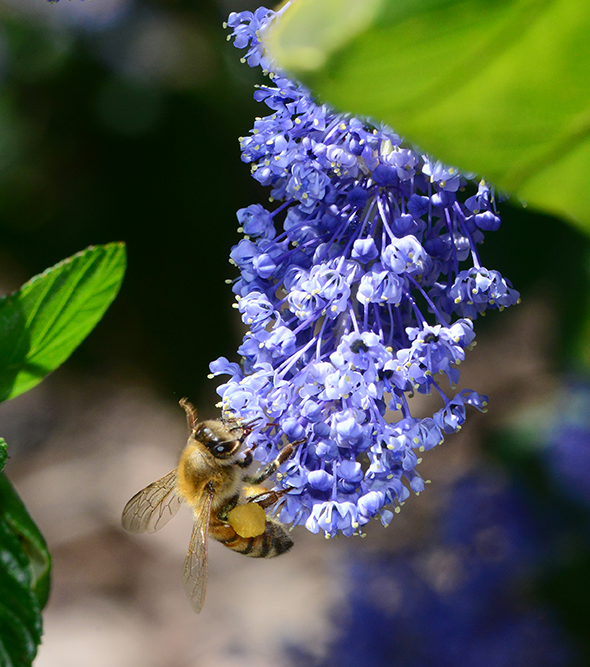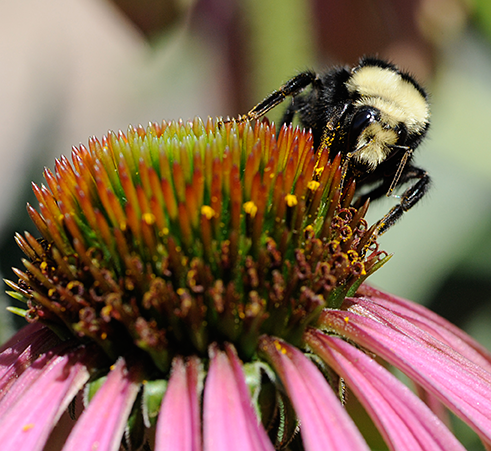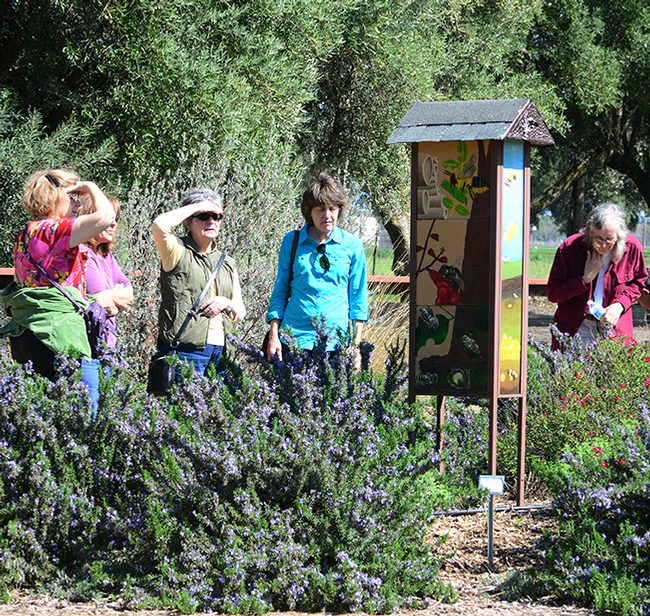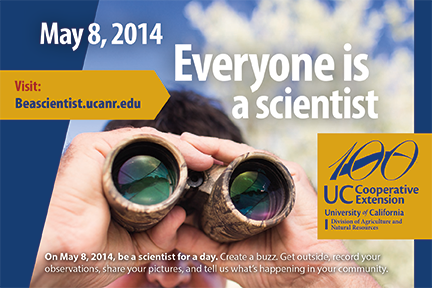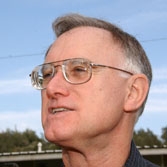Posts Tagged: colony collapse disorder
Pollinators in trouble
On April 30, Barbara Allen-Diaz, vice president of the UC Division of Agriculture and Natural Resources, will wear bees – live honeybees. The event is a fundraiser for undergraduate education, and Allen-Diaz, who has endured bee stings in the past, is willing to take the risk for this important cause. She'll have the help of a noted bee wrangler, UC Davis emeritus professor of entomology Norm Gary. Gary has performed such unlikely stunts as playing the clarinet while covered with honeybees. He will apply a synthetic pheromone to Allen-Diaz's hands to attract the bees, which he says are unlikely to sting unless provoked.
“I'll be holding a precious resource in my hands, one that is essential to life on earth,” says Allen-Diaz. “I'll be placing my hands in Norm's hands to raise awareness about the value of honeybees.”
While raising money for education is certainly a worthy goal, as Allen-Diaz says, the event also draws attention to the plight of our most important agricultural pollinator. In 2006, a number of beekeepers in the Western U.S. noticed their hives had lost 30 to 70 percent of their worker bees. The phenomenon, now known as colony collapse disorder (CCD), is still not fully understood, though a number of factors are believed to be involved. They include habitat loss or degradation and fragmentation, poor nutrition, certain bee management and agricultural practices, natural and chemical toxins, diseases, and parasites. Any one of these factors can affect the insects' ability to combat any of the others. Isolating a single cause, if there is one, has proved elusive.
Many of the fruits and vegetables on the tables of the world are pollinated by insects, particularly bees, and if they were to disappear, our sources of plant food would be restricted to grains and not too much else. It's no wonder CCD is such a concern (for example, see the United Nations Environmental Program 2010 report on Global Bee Colony Disorder and USDA, Honey Bees and Colony Collapse Disorder.
It's not just honeybees, either. Pollinators in general are on the decline worldwide, probably for many of the same reasons that are listed as factors in CCD. They have an essential ecological function on every continent except Antarctica, not merely in service to agriculture. Losey and Vaughn (2006) estimate the value to the U.S. economy of native insects (not honeybees, which are native to Europe) to be at least $57 billion.
As human population grows and becomes more urban, and as habitats get more fragmented, it is no longer adequate to focus conservation efforts merely in non-urban, non-working landscapes.
“We need to figure out how to accommodate as many native species as possible in these kinds of places,” says Patrick Huber of the City of Davis Open Space and Habitat Commission, which has adopted pollinator habitat enhancement as a working goal. The Commission is working to compile a GIS dataset of known big patches of habitat in Davis, in order map pollinator resources around town.
Huber is a geographer in the Landscape Analysis and Systems Research lab at UC Davis, where he focuses on spatial scale in conservation planning. He is working on a tool to help match gardeners with plants that will grow well in their regions, that are locally available, and that provide a network of resources for pollinators throughout the urban landscape and on into the agricultural landscape. For the moment this project is being piloted in Davis, but the hope is to expand it to other communities, tying in resources such as CalFlora.
A recent workshop at UC Davis sponsored by the California Center for Urban Horticulture, Your Sustainable Backyard: Pollinator Gardening, focused on this very issue: what gardeners can do to help pollinators, many of which are bees. (Of 19,500 known bee species in the world, 4,000 can be found in North America and 1,600 in California. There are at least 300 species of bee in Yolo County alone.) Urban gardeners can help pollinators by:
- Planning for succession blooming (in the Central Valley, that means late winter through fall)
- Putting plants in clumps at least 4 feet long if possible (honeybees, especially, like to specialize)
- Putting in plants that provide both nectar and pollen (nectar is fuel for adult bees, pollen is protein for the young)
- Using native plants where possible; they're drought tolerant and have what our native bees need
- Avoiding most-toxic pesticides and herbicides
- Providing a clean source of water (a slow-dripping tap on a sloped surface is ideal; bees like to drink from very shallow sources)
- Providing cavity nest holes in wood for carpenter and other bees
- Leaving some areas of gardens unmulched for ground-nesting bees
There are ways the agricultural landscape can be made more hospitable, too. Neal Williams, professor of entomology at UC Davis, has been working on a project to install 600- to 800-meter plots of flowering plants alongside large fields as resources for pollinators. This has moved out of the trial phase into test plots in coastal and foothill areas as well as in the Central Valley.
Meanwhile, we can all help count our pollinators on May 8, the Day of Science and Service to celebrate 100 years of Cooperative Extension in California. We'll be conducting our own pollinator count here outside the ANR building in Davis: join us, or let us know about yours!
Many thanks to Kathy Keatley Garvey for use of her photos.
About those honey bees...
Colony collapse disorder (CCD) has certainly increased public awareness about bees — but also public misinformation about bees in general.
CCD, the mysterious phenomenon characterized by adult bees abandoning the hive, leaving behind the queen bee, immature brood and stored food, surfaced in the winter of 2006. Scientists believe CCD is caused by multiple factors: diseases, viruses, pesticides, pests, malnutrition and stress.
Meanwhile, misinformation about bees continues to surface. Posts on Facebook, Twitter, Pinterest and other social media often caption a syrphid fly as a bee or a syrphid fly as a bumble bee. Magazine and newspaper editors frequently misidentify a syrhpid fly (aka flower fly and hover fly) as a honey bee. Even the cover of the well-respected book, Bees of the World, by Christopher O’Toole and Anthony Raw shows a fly, not a bee. University of Illinois-based entomologist Alex Wild, who received his doctorate from UC Davis, mentioned the error in his Scientific American blog.
So, we asked noted honey bee authority Eric Mussen, UC Cooperative Extension apiculturist based in the UC Davis Department of Entomology: What should the general public know about honey bees? Can you share some basic information? A honey bee primer?
First of all, honey bees are not native to the United States. European colonists introduced them to what is now the United States in 1622. The site: the Jamestown colony in Virginia. Then in 1853, the honey bees were introduced to California. The site: San Jose.
“Honey bees,” Mussen says, “are commercial pollination workhorses, while native bees — mostly solitary — pollinate the native plants of field and forest. Around 250 commercial California beekeepers operate about 500,000 honey bee colonies, approximately one-fifth of the country’s supply. Over 72 percent of commercial crop pollination is conducted in California, and about one-third of our daily diet is dependent upon bee pollination. We also have about 6,000 small-scale or hobby beekeepers, who tend to keep one to five colonies.”
Mussen attributes CCD with “fomenting great media and public interest. It also sparked an increase in the number of small scale beekeepers.”
About 60,000 individuals, including the queen, thousands of worker bees (sterile females) and drones (male bees) comprise a colony in the late spring/summer.
“Up to a thousand drones are present during the mating season,” Mussen says, “but they get evicted at the end of the fall.”
The drones serve one purpose: to mate with a queen. And then they die. When a virgin queen is about 10 days old, she will mate with 12 to 20 drones on one or more mating flights. The queen returns to the hive and begins laying eggs, as many as 2,000 eggs a day.
“Bees are vegetarians and live on pollen and nectar obtained from flowers or extra-floral nectarines,” Mussen says. “A mix of pollens is required to meet honey bee nutritional needs.”
During the active season, a honey bee colony each day requires an acre-equivalent of blooms in order to meet its nutritional needs. Bees store both pollens and honey for winter food. The bees usually forage within five miles of the hive. Nutrition is crucial to a healthy hive.
“Malnutrition impairs the protective physiological systems — particularly the immune system and detoxification system — and leads to less productive and shorter-lived bees,” Mussen says.
The bottom line: “More research is required to find better ways to reduce populations of honey bee parasites, reduce levels of honey bee diseases, and develop beekeeping management practices that prevent excessive losses of honey bee colonies during the year.”
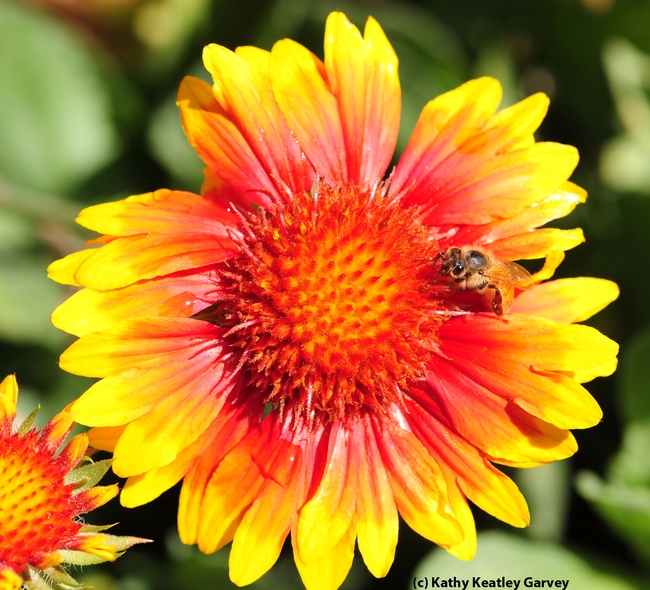
Honey bee on blanket flower, Gaillardia. (Photo by Kathy Keatley Garvey)
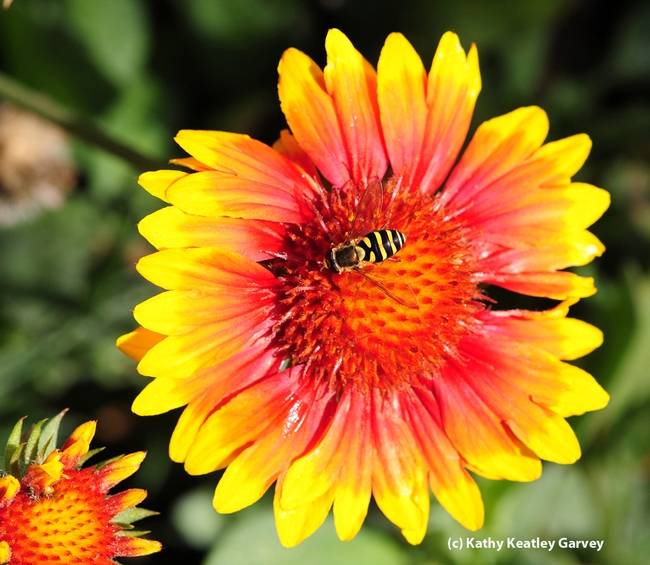
This floral visitor, a syrphid fly, is often mistaken for a honey bee. (Photo by Kathy Keatley Garvey)
No explanation yet for mysterious bee deaths
Even though scientists have been studying colony collapse disorder of honeybees for five years, the relentless bee mortality still has them mystified, according to a segment that aired on PBS' NewsHour yesterday.
"We really don't seem to have accomplished a whole lot, because we're still losing, on an average, approximately 30 percent or more of our colonies each year. And that's higher than it used to be," UC Cooperative Extension bee expert Eric Mussen told reporter Spencer Michels. "Only 25 percent of the beekeepers seem to have this CCD problem over and over and over. The other 75 percent have their fingers crossed and say, I don't know what this is, but it's not happening to me."
Michels outlined some of the research into the possible causes of persistent bee decline. At UC Davis, scientists are trying to find ways to improve bee health by changing what they eat and selectively breeding healthier, disease-resistant bees. At UC San Francisco, scientists are extracting DNA or RNA from healthy bees to analyze what viruses or bacteria are present.
"We found four new viruses in this study, and one of them was so frequent, there was more of that virus present than every other virus that we have know about put together," said UCSF's Charles Runckel.
A beekeeper featured in the program said he maintains healthy bee colonies by keeping them "forever young." Randy Oliver splits his hives every year, taking half the bees out and starting a new hive.
"That simple act of splitting gives the bees a fresh start. And, in nature, that's what they do. Bees -- bees reproduce frequently. They swarm every spring, and they give themselves fresh starts. And that's what beekeepers are tending to do, too," Oliver explained.
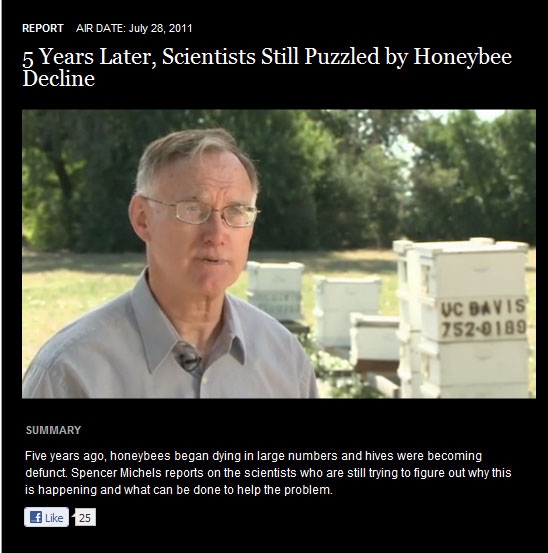
PBS
Marin team designed the Honey Bee Haven
When Jessica Brainard picked up a pint of Häagen-Dazs ice cream at a Sausalito 7-Eleven in 2008, she added a link to a chain of events that culminate tomorrow with the official grand opening of the Häagen-Dazs Honey Bee Haven at UC Davis.
Brainard was featured in a Marin Independent Journal article that detailed how she and three other local landscape designers followed a link on that fateful ice cream carton, leading to their having a substantial role in the creation of the half-acre garden that will raise awareness about the plight of the honey bee.
Interpretative planner Brainard, landscape architect Donald Sibbett, landscape architect Ann F. Baker and exhibit designer Chika Kurotaki won the garden design competition and a year's supply of Häagen-Dazs ice cream. Their winning design plan (pdf) can be viewed online.
The team designed the garden with:
Honeycomb Hideout, a space with large-blossomed plants and an over-sized honey bee sculpture that gives visitors a sense of a garden from a bees-eye point of view Waggle Dance Way, a path on which visitors can meander through a natural landscape Pollinator Patch, full of berries and fruit trees Save-the-Bee Sanctuary, which tells the story of how bees pollinate much of America's food My Backyard Garden, with perennials and a lawn substitute, which illustrate how almost anyone can make a garden bee-friendly Nectar Nook, shows how to create a natural-looking oasis for bees with native and drought-tolerant Mediterranean plants Langstroth Lane, a walkway with a pair of trellises that gives visitors the sense of entering and exiting frames of a bee box "It was really important to give visitors an emotional connection to the plight of honey bees," Brainard told reporter Debbie Arrington. "We wanted them to understand how important they are to our food production and to our life. This garden celebrates that and provides practical examples to promote bee-friendly backyards." The garden, planted last year, already houses a vast diversity of bees, including bumblebees, carpenter bees, leaf cutters, borer bees, mason bees and sweat bees. The grand opening event, free and open to the public, is from 10 a.m. to 2 p.m., Saturday, Sept. 11, at the Harry H. Laidlaw Jr. Honey Bee Research Facility, Bee Biology Road, University of California, Davis. More information is available in a news release by Department of Entomology writer Kathy Keatley Garvey.
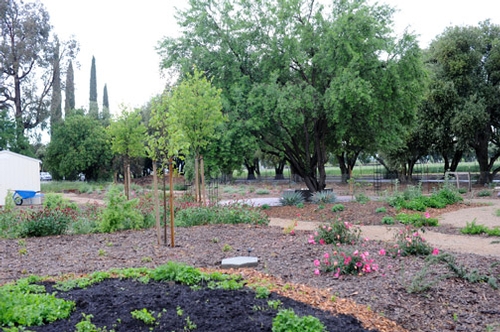
The honey bee haven at UC Davis.
Honey bee haven home to 6 million bees
The new Häagen-Dazs Honey Bee Haven at UC Davis will be dedicated Sept. 11, but it is already buzzing with activity, according to a feature that appeared in Saturday's Sacramento Bee.The half-acre refuge is already home to more than 6 million bees representing 55 species, including bumblebees, carpenter bees, leaf cutters, borer bees, mason bees and sweat bees, the article said.
The garden was transformed from a neglected patch of land - described as a giant concrete brick by the program manager - into a bee sanctuary of mostly drought-tolerant, easy-care perennials and shrubs that bloom year round. The compost for the garden came from scraps from campus cafeterias. A giant honey bee sculpture sits on a pedestal decorated with mosaics by schoolchildren, UC Davis students and others.
Interest in bees has grown in recent years due to the insects' well-publicized struggle with colony collapse disorder.
"A lot of people are asking, 'What can I do to help?'" UC Davis entomologist Eric Mussen told Bee reporter Debbie Arrington.
Many California crops are dependent on bees for pollination, such as melons, squash, cucumbers, cranberries, raspberries, strawberries, blueberries, sunflowers, alfalfa, buckwheat, clover and almonds.
"We grow more than 700,000 acres of almonds in California, and every acre needs two to three hives," the story quoted Kathy Garvey of the UC Davis entomology department.
The Häagen-Dazs Honey Bee Haven is open to the public everyday from dawn to dusk. The grand opening is from 10 a.m. to 2 p.m. Sept. 11. For more information and directions to the haven, see the Häagen-Dazs Honey Bee Haven website.

The bee sculpture in the Häagen-Dazs Honey Bee Haven at UC Davis.

